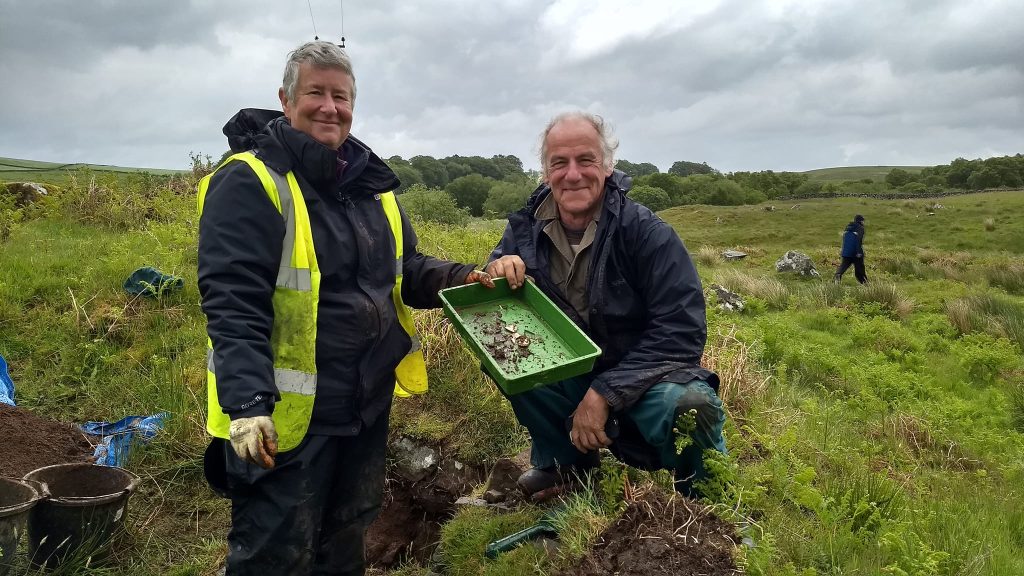Come and join the ‘Can You Dig It’ project for their final dig as they investigate the earlier boundaries of Barrhill Wood! Can You Dig It will be spending three days test pitting within Barrhill Wood, Kirkcudbright and they are looking for volunteers to help them investigate some of the earlier features hidden amongst its trees.
As you wander through Barrhill Wood, you can spot traces dating back to the late medieval period – the line of an old, hollowed roadway, tumbled stone walls and earthen banks which criss-cross their way throughout the trees. These are the remains from the various transformations that the area has seen throughout its lifetime, including changes by the Earls of Senwick who established the original plantation in the late 18th century. New information gained from LiDAR and recently discovered mapping shows the locations of previously unknown ditches which appear to pre-date what was marked in the 18th century, and the Can You Dig It project is aiming to investigate the nature of these features and see just how old they might be.
The plantation at Barrhill Wood was originally established by the Earls of Senwick in the 18th century and a number of boundaries can still be seen within the wood surviving from late 18th century enclosures used for pasture. But local archaeologist David Devereux has spotted traces of features on LiDAR which appear to pre-date these. One ditch, which spans the width of the wood, might relate to an earlier boundary shown on a newly discovered earlier estate plan from Yale. While traces of two other possible ditches enclosing the highest point in the wood only appear on LiDAR and do no correlate with any of the available mapping – this could suggest that they’re even earlier.
Over the course of three days on-site, Can You Dig It is aiming to investigate these traces to see what they might be and how old they could date back to. Volunteers will get the chance to take part in an archaeological dig into the possible ditches to see what they can find. They will be shown the various aspects involved in archaeology from digging, recovering artefacts right through to recording what is found – you don’t have to be able to dig to help out as there are plenty of tasks such as recording, drawing, survey and photography that they will need help with. Digging is only just the start of an archaeological excavation.
This is a free event and open to everyone, no previous experience necessary. So why not come along, spend a day in the beautiful setting of Barrhill Wood and have a go at some archaeology – who knows what you might uncover!
The Days are advertised separately, with people able to attend a single day or multiple days as suits. For more information, or to book your place, search Eventbrite.co.uk for ‘Galloway Glens’ or access the links directly as follows:
- 7th August: https://www.eventbrite.co.uk/e/test-pitting-at-barrhill-woods-tickets-687155469507.
- 8th August: https://www.eventbrite.co.uk/e/test-pitting-at-barrhill-wood-kirkcudbright-tickets-687167064187.
- 9th August: https://www.eventbrite.co.uk/e/barrhill-wood-test-pitting-kirkcudbright-tickets-687171868557.
Claire Williamson, Senior Archaeologist on the Can You Dig It project said:
“We’re really excited to be heading back into the field again for Can You Dig It’s final dig, and it’s great to be heading back to the site of one of our very first projects – Barrhill Wood. Due to being undisturbed, often for centuries, while the world around them has developed, Scottish woodlands have the possibility to contain some of our most significant archaeological features protected beneath their canopies. We won’t know what we will uncover until we put our spade into the ground, but we would love your help to find out!”
The Can You Dig It project is funded 50/50 by The National lottery Heritage Fund and Historic Environment Scotland. It forms part of the broader Galloway Glens Scheme. Jan Hogarth, Galloway Glens Education & Community Engagement Officer, said:
“It is our last Galloway Glens CYDI event at Barrhill Woods, Kirkcudbright and we are so grateful to Claire Williamson and her team for working with us over the years to upskill us all. These three days of trial pitting will give everyone the chance to develop their test pitting skills at a site up on the hill above Kirkcudbright which would have been important through hundreds and maybe thousands of years. Who knows what we might find and if we don’t find much, we will have improved our archaeology skills and had a lovely time wondering how people engaged with this site in the past, and sharing our passion for archaeology with each other.”
Our thanks go to Forestry & Land Scotland and Kirkcudbright Development Trust for supporting the work.





